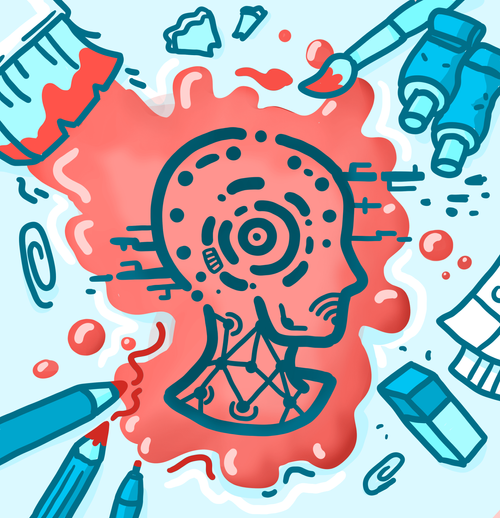Unleashing the Creative Potential of AI: The Artistic Revolution
AI art has been developing for decades, and with the advent of machine learning, has become capable of creating art completely independently, rivaling even the most skilled human artists.
Reading Time: 4 minutes

You have spent the past two hours scrolling through your social media feed instead of doing your homework. Right when you decide to finally quit scrolling and be productive, something on your feed catches your eye: a hyper-realistic painting of a cute cat wearing a suit. As you admire the painting, you open the caption to find out which incredible artist made this artwork, hoping to follow them. Surprise! It was actually made entirely by AI. But how is it possible that AI can create such realistic artwork?
AI, short for artificial intelligence, is the ability of a computer to mimic human problem-solving and learning. This field is currently expanding rapidly into multiple industries, including the art industry.
The foundation of early AI art was based on computer art. Frieder Nake was a prominent computer art creator in the 1950s and ‘60s. Nake’s art consists of simple geometric shapes, such brightly colored squares. He assigned each geometric shape a number, which was then assigned a color and size. The computer then randomly generated numbers to create patterns, which were combined together to make the final product.
In 1973, artist and computer scientist Harold Cohen coded a set of algorithms known as AARON, which became the first major form of AI art. Cohen created AARON to mimic his own artistic style by coding rules for it to follow. Unlike Nake’s art, AARON was able to draw freehand lines rather than just geometric shapes, making the art more human-like. AARON used the rules set by Cohen, along with its preceding strokes, to decide how to draw the next line.
AARON was hooked up to a robotic arm that spread ink on a canvas based on the AI’s decisions. At first, it was only able to create simple, abstract artworks made of black and white lines, but by following more advanced algorithms, it became capable of drawing more complex and colorful art pieces. Though AARON could create an infinite number of original artworks, it is only able to create artworks within the style coded by Cohen. If AARON was to create art in new styles, Cohen would have to code new rules. Entirely autonomous AI art that was capable of learning new styles did not become available until decades later.
After years of research and development, huge strides in machine learning have revolutionized AI, including AI art. Machine learning is a division of AI, which is defined as the ability of a computer to learn without direct human intervention. It is made possible by the AI model analyzing huge amounts of information. This analysis is done through a method called deep learning, a subset of machine learning where massive amounts of data are analyzed in layers, mimicking the way the human brain learns. It allows for data to be analyzed more comprehensively, leading to more realistic AI art. Deep learning also makes text-to-image AI art possible, which allows us to analyze millions of images associated with words and classify them into groups.
Generative adversarial networks (GANs) are a type of machine learning model invented in 2014. They utilize deep learning to generate products, such as art. The defining feature of GANs is their use of two neural networks, which are computer programs composed of artificial neuron “nodes.” One neural network is the generator and the other the discriminator. The generator uses deep learning to analyze many photos of the same subject and teach itself what that subject looks like. The generator then uses its learning to recreate a picture of the subject. Afterwards, the discriminator analyzes the image from the generator and tries to determine if the image is a “fake” image produced by the generator or a “real” image produced by humans. This process repeats until the generator produces an image that fools the discriminator into believing that it was made by humans. Using this method, the generator and discriminator train each other to improve their artworks’ realism. When a user inputs a prompt into an AI art generator, the AI finds the images classified under those words and uses analysis to generate art using them.
With its recent boom in popularity, AI art has sparked controversy on whether its benefits outweigh its drawbacks. One benefit of AI art is being able to create an infinite number of original artworks very quickly. This makes art more accessible to the general public; people can use free art generated by AI rather than spending time creating art or spending money commissioning an artist.
Despite the fact that AI art does come with a list of great benefits, it also has ethical dilemmas. Though increased accessibility to art is beneficial to the general public, AI art also competes with traditional artists. For instance, in 2022, an artwork created by AI received the first place award at the Colorado State Art Fair, enraging many traditional artists. Another prominent issue often brought up with AI art is the ethics concerning where credit is given. Modern AI art generators that use deep learning are only made possible through the analysis of huge image databases. When AI creates art, it does not credit any of the original artists or photographers whose artworks it analyzes; many have argued that this is a violation of copyright laws.
The popularity of AI art has recently exploded and shows no signs of slowing down. There are already hundreds of advanced AI art generators that create hyper-realistic artworks. Many of them are programs that you can try out for free yourself, such as Craiyon AI, NightCafe, and Fotor. Though AI art is shrouded in controversy, there is no questioning that it has already established its place in the art industry.
